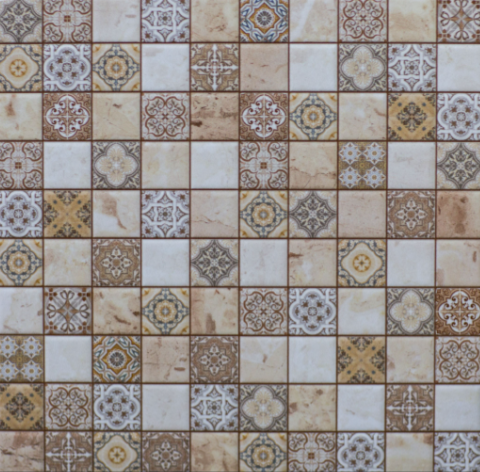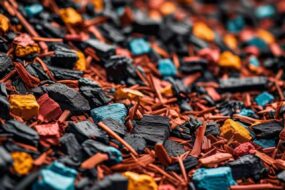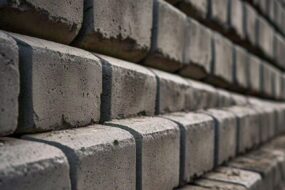
For centuries tiles have been an integral part of architectural and interior design given that both beauty as well innumerable profit. Be it your bathroom, kitchen or any other space you are planning to renovate learning about different types of tiles available in the market along with their utilities and installation ways can help in making more educated decisions. This read will guide you with the help of rudiments about tiles along shell different aspects to make it a complete sense.
1. Introduction to Tiles
A tile is generally a flat, thin object usually square or rectangular in shape. Tile can be made of ceramic, stone (such as marble), metal, baked clay(ceramic porcelain,or glass and other stiff-wearing material.). existing is widely used in construction to make floors, walls, roofs and many other visible surfaces. This is why tiles have a wide range of designs that can be used for both suburban and commercial projects making them one of the most preferred materials.
1.1 History of Tiles
Tile has been used for several thousand years. Tiles use to be part of decoration plan since the ancient civilization (Egyptians, Romans and Persians) decorating homes, public buildings / temples with this simple combination item. As the centuries went by, tile-making developed a little more according to each culture. Top Sliding Bar Today tiles are a sought-after last in modern architecture, where tradition merges with fashion.
2. Types of Tiles
Tiles come in different varieties and each have its own characteristics that suit such application. The following is an overview of the basic types;
2.1 Ceramic Tiles
Ceramic Tiles are made from clay and can be glaze or unglazed. Some of their key features include affordability, easy install and a vast selection. If you think of ceramic tiles, they are a very popular choice for flooring and walls in bathrooms, kitchens etc., as these areas call rainproof surfaces.
2.1.1 Advantages
– Cost-effective
– Easy to clean and maintain
– Numerous colors and patterns
2.1.2 Disadvantages
Not as strong as other kinds
Chippable or crack under hard impact
2.2 Porcelain Tiles
While porcelain tiles are a variety of ceramic tile, they are made from denser clay and fired at higher temperatures. This material is a lot more dense, stronger and less porous than typical ceramic tiles. High-Traffic and Exterior — Porcelain tiles
2.2.1 Advantages
Extremely durable and wear-resistant
Water proof, can be used in wet areas
– Comes in a large variety of styles, including some that look like natural stone
2.2.2 Disadvantages
– Expensive in comparison ceramic tiles
—Weighs more, can be difficult to cut and install
2.3 Stone Tiles
Natural luxurious looks of stone tiles (Marble, Granite Limestone and slate) These tiles have distinct textures and patterns that make style attractive as no two stone are exactly the same. These copper gutters are an idea, House S house by Grosfeld van der Velde Architecten intesting detail like the tile based floor is employed around again in kitchen and entry.
2.3.1 Advantages
Long lifespan
– Unique, natural appearance
– Adds value to a property
2.3.2 Disadvantages
• Needs to be resealed periodically in order to retain appearance.
– Expensive and heavy
Prone to staining without proper upkeep
2.4 Glass Tiles
Made from transparent layers of very thin glass with a semi-translucent coating Because metal and glass offer shiny, reflective surfaces, they are commonly employed as accents in bathrooms and kitchens. Types: Glass tiles are colorful, suitable for decorative uses.
2.4.1 Advantages
Very stain resistant
– Shiny finish increases the light in a room
Vibrant color options
2.4.2 Disadvantages
– Can be slippery when wet
Click here to buy for $22 at Beautylish — Note: ships everything but candles and alcohol :)[also on Princess Polly, just sets you back a bit]Expensive (and chips easily)
2.5 Cement Tiles
It is handmade and has bold colors with complex patterns. Another word, cement tiles. Homeowners use them a lot in both traditional and current designs or locations like kitchens, bathrooms, patios.
2.5.1 Advantages
– Customizable designs
Long Lasting When Sealed
— Ecologically clean products made from natural components
2.5.2 Disadvantages
* Unsealed, vulnerable to staining
The pad can fade over time if you wear it down without proper maintenance. Different types of brake pads and rotors require attention. If a rotor has been cut (resurfaced) more than 1-2 times, you must replace it.
2.6 Mosaic Tiles
A mosaic is any small tile, such as a square drive motley, that manufacturers create from ceramic, glass, or stone. Artists arrange these tiles to create various kinds of patterns in designs, applying them widely as beautiful decore in kitchens, restrooms, and swimming pools.
2.6.1 Advantages
Versatile in detailed zeros and applications
– Easy to customize
– Makes any space look more artistic
2.6.2 Disadvantages
– Time consuming installation process
Grout lines are difficult to clean
3. Selecting the tile for your room
Factors such as the room you are tiling, how much foot traffic this area of your house gets, what look or feel you want to achieve and your budget play in a major role while result out the right type of tiles. This guide will show you how to choose the perfect offer:
3.1 Think About What the Room is For
Room where you will install tile The most important step in choosing the perfect tile for your home is to consider the room they are going into. While bathrooms and kitchens might need water hideous, easy to clean tiles the living room or bedroom floors may be comfortable as well aesthetical.
3.2 Foot traffic, and durability
Tiles in busy areas, such as hallway or entry way would do best with a robust and durable tile. The best selections made for these areas could be the ceramic and stone tile.
3.3 Style and Aesthetics
The color, even the pattern and potentially texture of your tile should be consistent with how you want the bathroom to look in this style OFFSETTING TEXTURES These glossy, fashionable neutral tile may go well with a modern theme. Textured stone or patterned cement tiles can also work well for a more traditional, rustic feel.
3.4 Budgetary limitations
While some ceramic tiles cost as little as 75 cents per square foot, others can range from $75 to more than $100 per tile, depending on the quality of the work. While you like things to be aesthetically appealing, your budget affects that too. Remember however to include the costs of installation as more intricate designs or materials will drive up labor expenses.
4. Installation Process
Installing the tile is one of many crucial steps that must be done properly. Much can go wrong if you don’t do things the right way, whether it is a DIY or hired job.
4.1 Surface Preparation
The surface needs to clean, dry and level before you can install the tile. And given enough time tiles will either crack or lift if not everything is done perfectly. In some cases, you may have to put down a new layer of prop up backer board (oriented strand board) for stability.
4.2 Laying Out the Tiles
Mapping out the placement of your design before you start tiling will help to avoid weird cuts as well majorly keep your design equal. First, find the center of your room and tile from this point outward. The way it is done — so to speak; this helps add balance.
4.3 Applying Adhesive
Spread tile adhesive evenly over the surface with a notched trowel Place each tile into the adhesive and use spacers to keep even gaps between them for grout. Work in small areas as you don’t want the adhesive to dry out before they’re laid down.
4.4 Cutting Tiles
Many edges and corners are sure to exist in a space, so you definitely need to take care when cutting tiles. You can make one of these cuts even more accurately with the help of a wet saw or tile cutter. Before you cut anything, always measure twice to avoid wasting product.
4.5 Grouting
After setting the tiles in place, remove spacers and apply grout to fill joints. Rub a rubber float over the surface to work grout into all joints. As soon as the grout solidifies, remove excess with a humid sponge and wipe the tile dry.
5. Maintenance and Care
To keep tiles looking new, you need to clean them regularly to prevent the buildup of dust and dirt, which can gradually diminish their appearance over time. Some Examples With Their Care:
5.1 Cleaning
Cleaning is essential in keeping your tiles looking new. Most tile are best cleaned with warm water and a mild detergent. This material is more sensitive than ever And harsh cleaners will scratch the surface (image: Gettty)
5.2 Sealing
Non-epoxy grout can stain and crack, while unsealed natural stone and cement tile can become stained. Ensure you reseal these tiles at the intervals recommended by the manufacturer to help keep them looking and performing like new.
5.3 Repairing Damage
When you discover damaged or broken tiles, you should fix them as soon as possible to prevent additional damage. Often, individual tile were still removable with little disruption to the neighboring tile.
5.4 Grout Maintenance
Grout can stain and discolor over time. Regularly clean grout lines, also install a sealer to protect them from moisture and dirt.
6. New Tile Technology
With so many breakthroughs in the tile industry, new things keep coming out that help people slip in tiles to be more functional or aesthetically pleasing.
6.1 Digital Printing
The type of digital printing allows for very intricate and realistic designs. This development allows for a greater selection of patterns, including ones that replicate natural materials such as wood, marble and concrete.
6.2 Large-Format Tiles
Modern design has been leaning towards larger format tiles. These larger tiles which usually are 24 inches or more will give a uniform exterior, with less grout lines that makes your room feel even bigger and wider.
6.3 Thin Porcelain Tiles
A lightweight, low-profile version of thick tile are thin porcelain tiles as little as a few millimeters wide. They are quick to be installed over existing surfaces, so demolition and renovation projects can move faster.
6.4 Smart Tiles
Some of the tiles have an attitude offering heating, lighting and even touch controls. Useful For [tile-light]
today and in the advent of comfortable, convenience homes.
7. Eco Tiles sustainably gives a whole new light to eco-friendly tile.
As environmental issues become more of a concern, the appeal for sustainable building materials have risen. The tile industry has been taking eco-friendly initiatives that minimize the damage caused to the environment.
7.1 Recycled tiles
Most-manufacturers-now-produce-tile-from-recycled-glass-metal-ceramics Tiles made from recycled glass or rubber, for example, require less raw material and keep waste out of landfills.
7.2 Energy Efficient Manufacture
A number of tile manufacturers have committed to environmentally friendly production methods that reduce greenhouse gases. Some companies are making food tiles that consider the environment. Look out for those which have certifications like LEED.
7.3 Low-VOC Tiles
Harmful to indoor air quality: VOCs. When manufacturers use fewer volatile organic compounds in tiles and adhesives, they allow fewer of these chemicals to escape into a space, which is better for the people who occupy the living areas.
8. Conclusion
Tiles are central in home design due to their functionality and aesthetic appeal. These kinds of information empower you to reach the high volume service providers at your bathroom, kitchen and whole living place tile dealers. Tiles offer unlimited opportunities for creativity and self-expression, from the timeless nature of stone to all available colors in clay and glass. Tile can last for a long time, many tile installations are decades old and still good enough looking to be present.
Look for tile that will become radically more versatile and user-friendly, as designers find new (and old) ways to make them work. Whether you’re renovating or building from scratch, you can always rely on tiles as a safe bet for any room.










One reply on “Tiles: A Complete Guide for You”
[…] both professionals and home dyers, the toolbox is a compulsory asset that holds tools needed for all types of jobs. Whether you are fixing a broken cupboard door […]